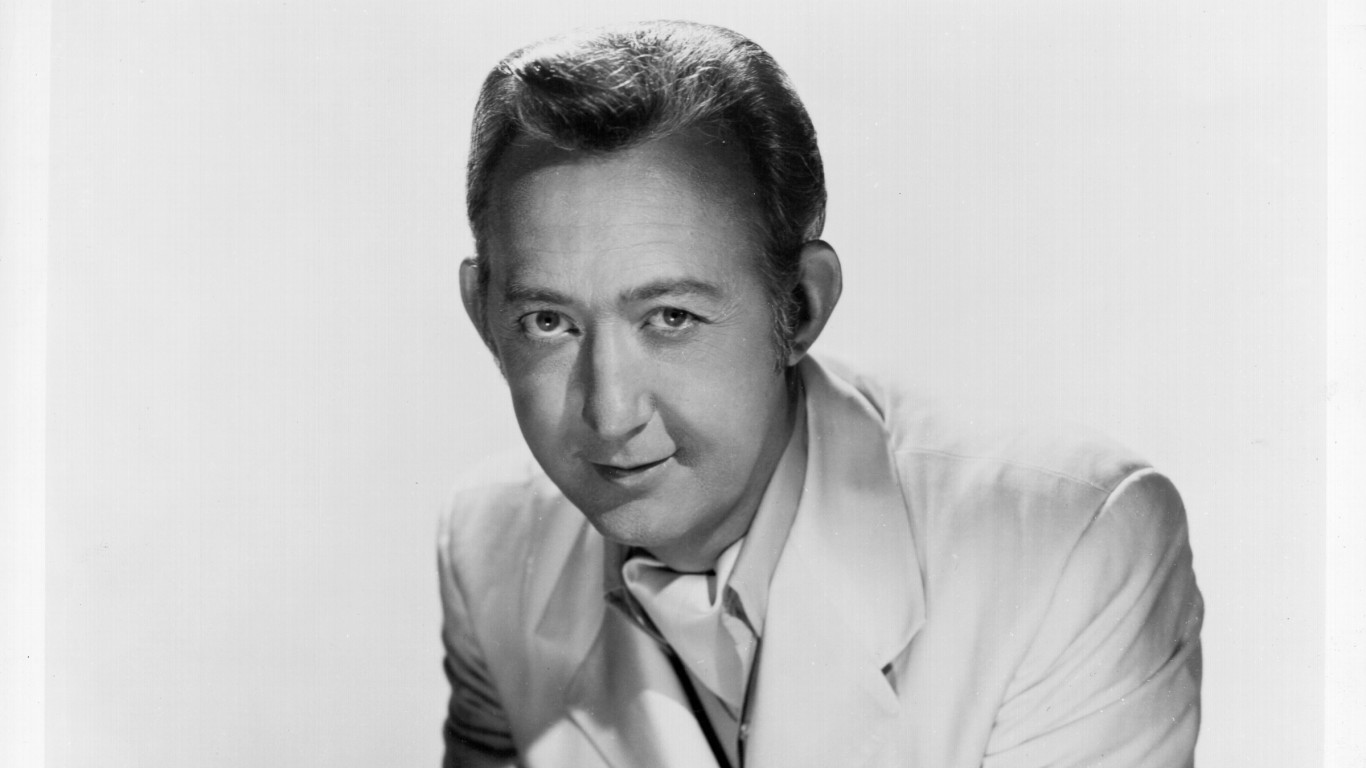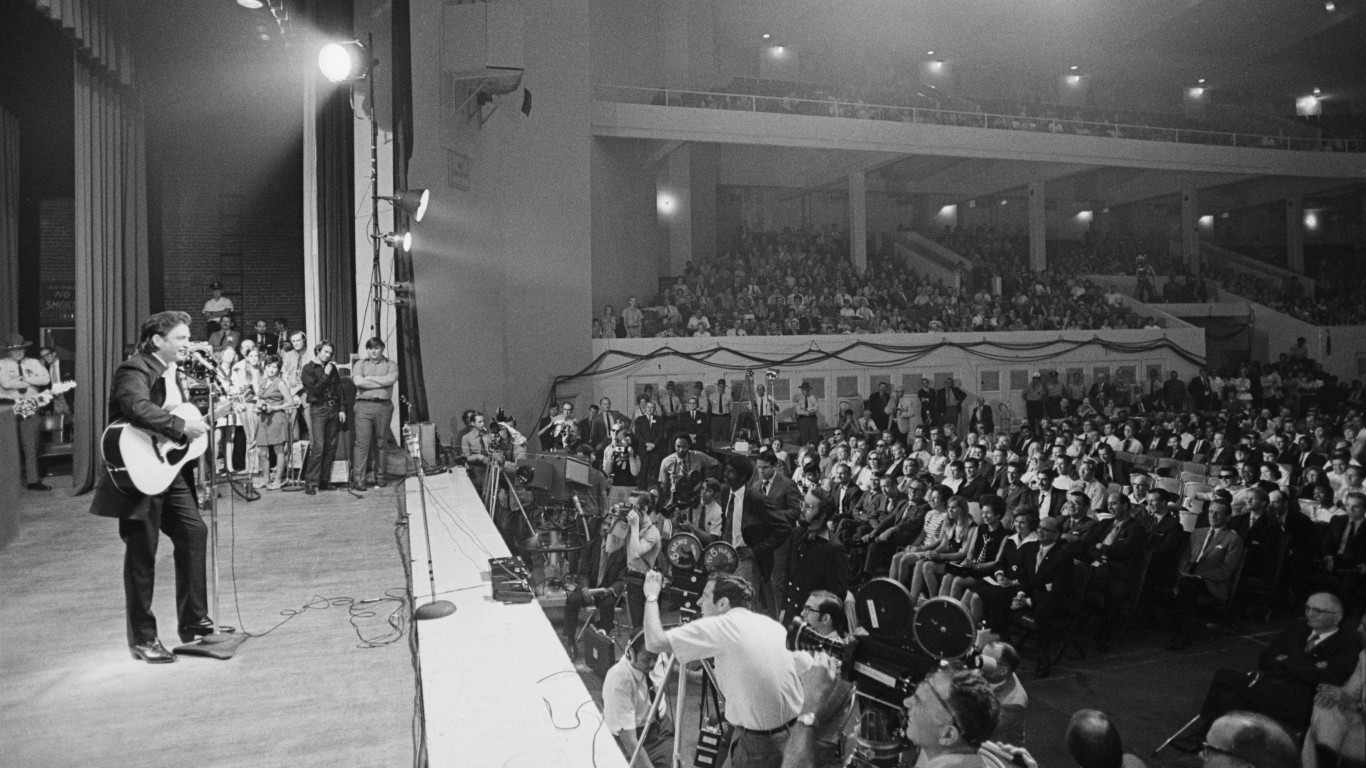Special Report
Every Country Music Song of the Year Since 1967

Published:
Last Updated:

The countdown has started for this year’s Country Music Awards — among the music industry’s most prestigious honors. This year’s ceremony is scheduled to be broadcast live on ABC-TV on Nov. 13.
The awards are given annually by the Country Music Association (CMA), an organization founded in 1958, ostensibly to help stem the tide of rock and roll, which was then seen as threatening to take over the airwaves and marginalize the country genre.
The first ceremony was held in 1967, and the following year, it was broadcast for the first time on television — making it the longest-running live annual music awards program on TV. (The second annual Grammy Awards were aired in weekly episodes in 1959, but were first shown live only in 1971. Click here to see every Grammy Song of the Year since the awards started.)
Award-winners in 12 categories, who receive hand-blown Italian crystal trophies at the CMAs are nominated and selected by the organization’s 7,400-plus members.
For Song of the Year, an accolade accorded to the songwriters (not the performers, unless they’re one and the same), the CMA’s online explanation of the awards states “Any Country Music song with original words and music is eligible based upon the song’s Country singles chart activity during the eligibility period.” This year’s awards covers the period of July 1, 2018 to June 30, 2019.
A look through the Song of the Year winners shows a wide range of songs winning the prize. There are some written — and sometimes, but not always performed — by such stars as Kris Kristofferson, John Denver, K.T. Oslin, Alan Jackson, Vince Gill, and Taylor Swift, as well as those penned by behind-the-scenes figures known only to the country music industry.
Click here to see every country music song of the year since the CMAs began
There are plenty of love songs, of course, and plenty of tear-jerkers, as well as patriotic anthems, novelty tunes, and inspirational offerings. Some of these qualify as the most popular country songs of all time.
Many of the songs on this list have been recorded numerous times, sometimes as pop or R&B songs. Some have even charted more than once, by different artists. The awards, however, in all cases, are given to the versions released during the respective eligibility periods.
24/7 Tempo reviewed archived data from The Country Music Association (CMA) to determine the winners for the Song of the Year award, going back to the year of the awards’ inception in 1967.

1967: There Goes My Everything
> Songwriter(s): Dallas Frazier
> Performer / recording artist: Jack Greene
> Number of weeks on Billboard 100: 21 weeks between Nov. 5, 1966 and March 25, 1967
Dallas Frazier was one of country music’s most successful songwriters of the 1960s and ’70s. His hits included “Elvira,” “Mohair Sam” “All I Have to Offer You (Is Me),” and the non-country “Alley Oop,” as well as Country Music Association Song of the Year “There Goes My Everything” recorded by deep-voiced Jack “Jolly Greene Giant” Greene.
[in-text-ad]

1968: Honey
> Songwriter(s): Bobby Russell
> Performer / recording artist: Bobby Goldsboro
> Number of weeks on Billboard 100: 14 weeks between April 6, 1968
and July 6, 1968
Country and pop singer Bobby Goldsboro’s signature hit was penned by Bobby Russell, whose other big songs include “Little Green Apples” (which charted successively for Roger Miller, Patti Page, and O.C. Smith) and “The Night the Lights Went Out in Georgia.” The latter was recorded by Russell’s wife Vicki Lawrence, a stalwart on “The Carol Burnett Show.”

1969: The Carroll County Accident
> Songwriter(s): Bob Ferguson
> Performer / recording artist: Porter Wagoner
> Number of weeks on Billboard 100: 21 weeks between Nov. 9, 1968 and March 29, 1969
A classic ’60s car-crash song, “The Carroll County Accident” was a 1968 hit for Porter Wagoner. The song is the work of Bob Ferguson — a legendary songwriter, record producer, actor, and writer who is given credit for helping to establish Nashville as America’s country music capital.

1970: Sunday Mornin’ Comin’ Down
> Songwriter(s): Kris Kristofferson
> Performer / recording artist: Johnny Cash
> Number of weeks on Billboard 100: 15 weeks between Sep. 5, 1970 and Dec. 12, 1970
Rhodes scholar, singer-songwriter, and actor Kris Kristofferson saw four of his best-known works become hits in 1969 and ’70: “For the Good Times,” “Help Me Make It Through the Night,” “Me and Bobby McGee,” and this song, whose interpretation by Johnny Cash rose to No. 1 on the Billboard U.S. Country charts.
[in-text-ad-2]

1971: Easy Loving
> Songwriter(s): Freddie Hart
> Performer / recording artist: Freddie Hart
> Number of weeks on Billboard 100: 23 weeks between July 17, 1971 and Dec. 18, 1971
Freddie Hart, born Frederick Segrest, both wrote and recorded this country standard, achieving his first hit as a performer at the age of 44. His songs had earlier been recorded by such luminaries as Loretta Lynn, Patsy Cline, Porter Wagoner, and Buck Owens.

1972: Easy Loving
> Songwriter(s): Freddie Hart
> Performer / recording artist: Freddie Hart
> Number of weeks on Billboard 100: 23 weeks between July 17, 1971 and Dec. 18, 1971
The Country Music Association liked Freddie Hart’s “Easy Loving” so much that it named the tune Song of the Year twice in a row.
[in-text-ad]

1973: Behind Closed Doors
> Songwriter(s): Kenny O’Dell
> Performer / recording artist: Charlie Rich
> Number of weeks on Billboard 100: 18 weeks between Feb. 24, 1973 and June 23, 1973
While Charlie Rich’s original version of this song, by prolific songwriter and sometime performer Kenny O’Dell, hit No. 1 on the country charts, it was subsequently recorded by a wide range of other country, R&B, and pop artists. Among those who recorded the song are Loretta Lynn, Dolly Parton, Bettye LaVette, Perry Como, Percy Sledge, Tom Jones, and Bobby Womack.

1974: Country Bumpkin
> Songwriter(s): Don Wayne
> Performer / recording artist: Cal Smith
> Number of weeks on Billboard 100: 10 weeks between April 6, 1974 and June 8, 1974
This “story song” was singer Cal Smith’s second No. 1 hit on the country charts. It won songwriter Don Wayne top country song awards from the CMA and the Academy of Country Music as well as the Songwriter of the Year honor from the Nashville Songwriters Association International.

1975: Back Home Again
> Songwriter(s): John Denver
> Performer / recording artist: John Denver
> Number of weeks on Billboard 100: 11 weeks between Oct. 19, 1974 and Dec. 28, 1974
John Denver was the well-loved composer and sometimes singer of such winsome country-folk hits as “Take Me Home, Country Roads,” Rocky Mountain High,” “Leaving on a Jet Plane,” and “Thank God I’m a Country Boy,” as well as this country and adult contemporary chart-topper.
[in-text-ad-2]

1976: Rhinestone Cowboy
> Songwriter(s): Larry Weiss
> Performer / recording artist: Glen Campbell
> Number of weeks on Billboard 100: 16 weeks between June 28, 1975 and Oct. 11, 1975
Glen Campbell had a hit with this popular country and pop song, but it was also recorded by several other country and non-country stars as diverse as Radiohead, Belle and Sebastian, Cher, and Bruce Springsteen. Songwriter Larry Weiss was not just a country specialist. He also wrote such pop and R&B hits as “Bend Me, Shape Me,” “Feelin’ Good,” and “Anyone Who Had a Heart,” but he still hit it with this one.

1977: Lucille
> Songwriter(s): Roger Bowling, Hal Bynum
> Performer / recording artist: Kenny Rogers
> Number of weeks on Billboard 100: 15 weeks between Feb. 12, 1977 and May 21, 1977
Kenny Rogers had his first major hit as a solo artist with this song after leaving The First Edition. It was composed by “outlaw country” songwriter Hal Bynum (“There Ain’t No Good Chain Gang,” “The Old, Old House”) in collaboration with Roger Bowling, who went on to co-write another Rogers hit, “Coward of the Country.”
[in-text-ad]

1978: Don’t It Make My Brown Eyes Blue
> Songwriter(s): Richard Leigh
> Performer / recording artist: Crystal Gayle
> Number of weeks on Billboard 100: 16 weeks between July 16, 1977 and Oct. 29, 1977
This quintessential Crystal Gayle hit was one of the most performed country songs of the 20th century. Songwriter Richard Leigh penned eight No. 1 songs, and 14 that hit the top 10, for artists including Ray Charles, Tammy Wynette, Don Williams, Reba McEntire, and Alabama.

1979: The Gambler
> Songwriter(s): Don Schlitz
> Performer / recording artist: Kenny Rogers
> Number of weeks on Billboard 100: 12 weeks between Oct. 28, 1978 and Jan. 13, 1979
“The Gambler” was a career-maker for both singer Kenny Rogers and songwriter Don Schlitz. Schlitz went on to write more than 20 No. 1 tunes and was named ASCAP’s Country Songwriter of the Year for four years running. Among his other hits were Randy Travis’s “Forever and Ever, Amen” and Mary Chapin Carpenter’s “I Feel Lucky.”

1980: He Stopped Loving Her Today
> Songwriter(s): Bobby Braddock, Curly Putman
> Performer / recording artist: George Jones
> Number of weeks on Billboard 100: 15 weeks between April 26, 1980 and July 26, 1980
This George Jones tear-jerker has been called the greatest country song of all time. Its authors are Bobby Braddock (“D-I-V-O-R-C-E,” “[We’re Not] the Jet Set”) and Curly Putman, who also wrote Dolly Parton’s first chart hit, “Dumb Blonde,” as well as “Green, Green Grass of Home” and other country classics.
[in-text-ad-2]

1981: He Stopped Loving Her Today
> Songwriter(s): Bobby Braddock, Curly Putman
> Performer / recording artist: George Jones
> Number of weeks on Billboard 100: 15 weeks between April 26, 1980 and July 26, 1980
This was the second time, after Freddie Hart’s “Easy Loving” in 1971 and ’72, that the Country Music Association graced the same song with its highest songwriting honor two years in a row.

1982: Always on My Mind
> Songwriter(s): Wayne Carson Thompson, Johnny Christopher, Mark James
> Performer / recording artist:
> Number of weeks on Billboard 100: 16 weeks between March 13, 1982 and June 26, 1982
Pop singer B.J. Thomas — known for such hits as “Raindrops Keep Fallin’ on My Head,” among other songs — was the first performer to record this love ballad, and Elvis Presley had a modest hit with it two years later. The definitive interpretation, however, is Willie Nelson’s 1982 Grammy-winning version, and it was in ’82 that the CMAs acknowledged it. Three songwriters take credit: Wayne Carson (who also wrote the Box Tops’ hit “The Letter”), Johnny Christopher (who also wrote the Elvis song “Mama Liked the Roses”), and Mark James (whose other triumphs include “Hooked on a Feeling” and “Suspicious Minds”).
[in-text-ad]

1983: Always on My Mind
> Songwriter(s): Wayne Carson Thompson, Johnny Christopher, Mark James
> Performer / recording artist: Willie Nelson
> Number of weeks on Billboard 100: 16 weeks between March 13, 1982 and June 26, 1982
As with “He Stopped Loving Her Today” and “Easy Loving” before it, “Always on My Mind” impressed the Country Music Association so much that they declared it Song of the Year two years running.

1984: The Wind Beneath My Wings
> Songwriter(s): Larry Henley, Jeff Silbar
> Performer / recording artist: Gary Morris
> Number of weeks on Billboard 100: 13 weeks between Aug. 27, 1983 and Nov. 19, 1983
Gary Morris had a number of country hits in the 1980s, and though this song was also recorded by the likes of Roger Whittaker, Sheena Easton, Lou Rawls, and Gladys Knight and the Pips, his version remained the highest-charting iteration until Bette Midler tackled it in 1989. Larry Henley — who had been part of a one-hit wonder band called The Newbeats (“Bread and Butter”) — co-wrote the song with Jeff Silbar, author of Lobo’s “Where Were You When I Was Falling in Love.”

1985: God Bless the USA
> Songwriter(s): Lee Greenwood
> Performer / recording artist: Lee Greenwood
> Number of weeks on Billboard 100: 12 weeks between June 2, 1984 and Aug. 18, 1984
Though many of his songs were romantic ballads, Lee Greenwood made it big with this rousing neo-conservative effort, which became an oft-heard theme song during GOP political campaigns in the Reagan and George H.W. Bush eras. He both wrote and recorded it, and it is known as his signature song.
[in-text-ad-2]

1986: On the Other Hand
> Songwriter(s): Paul Overstreet, Don Schlitz
> Performer / recording artist: Randy Travis
> Number of weeks on Billboard 100: 16 weeks between May 10, 1986 and Aug. 23, 1986
The first artist to record this song by the team of Paul Overstreet and Don Schlitz was a then little-known Randy Travis, whose 1985 version peaked at No. 67 on the Billboard country charts. Rereleased a year later, it soared to the top, becoming Travis’s first No. 1 hit. Overstreet also wrote songs for George Jones, Alison Krauss, and others, and recorded 11 top 40 country songs on his own. Schlitz made his name with the Kenny Rogers smash “The Gambler” (see above).

1987: Forever and Ever, Amen
> Songwriter(s): Paul Overstreet, Don Schlitz
> Performer / recording artist: Randy Travis
> Number of weeks on Billboard 100: 15 weeks between April 25, 1987 and Aug. 1, 1987
The second hit in a row penned for Randy Travis by Paul Overstreet and Don Schlitz, “Forever and Ever, Amen” also won the 1987 Grammy for Best Country & Western Song.
[in-text-ad]

1988: 80s Ladies
> Songwriter(s): K.T. Oslin
> Performer / recording artist: K.T. Oslin
> Number of weeks on Billboard 100: 15 weeks between May 9, 1987 and Aug. 15, 1987
A onetime musical theater chorus girl from Arkansas, K.T. Oslin made country music history by becoming the first woman to win the CMA Song of the Year title with this effort, which she also performed. It was the title song from Oslin’s debut album, which hit No. 1 on the country charts and was certified Platinum.

1989: Chiseled in Stone
> Songwriter(s): Max D. Barnes, Vern Gosdin
> Performer / recording artist: Vern Gosdin
> Number of weeks on Billboard 100: 17 weeks between Sep. 10, 1988 and Dec. 31, 1988
A performer as well as a songwriter, Vern Gosdin had a long career, ranging from childhood gospel singing through West Coast recordings with former members of The Byrds to numerous No. 1 country hits. “Chiseled in Stone,” from the album of the same name, was co-written by Gosdin and Nashville singer-songwriter Max D. Barnes. The song is about the death of Barnes’s son, Duane, who was killed in a car crash at age 18.

1990: Where’ve You Been
> Songwriter(s): Don Henry, Jon Vezner
> Performer / recording artist: Kathy Mattea
> Number of weeks on Billboard 100: 19 weeks between Dec. 2, 1989 and April 7, 1990
This poignant ballad won the 1990 Grammy for Best Country Song and garnered Kathy Mattea the award for Best Country Vocal Performance, Female. Mattea’s husband, singer-songwriter Jon Vezner, penned the song in collaboration with Don Henry, who has written or co-written for Miranda Lambert, Ray Charles, Blake Shelton, Conway Twitty, and Gary Morris, among many others.
[in-text-ad-2]

1991: When I Call Your Name
> Songwriter(s): Tim DuBois, Vince Gill
> Performer / recording artist: Vince Gill
> Number of weeks on Billboard 100: 17 weeks between June 23, 1990 and Oct. 13, 1990
Singer-songwriter-musician Vince Gill has the unique distinction of having shared songwriting credits on the CMA Song of the Year for three years straight. The one-time lead singer for Pure Prairie League and a Grammy winner for Best Country Vocal Performance, Male, Gill co-wrote this song with his then-manager, Tim DuBois.

1992: Look at Us
> Songwriter(s): Max D. Barnes, Vince Gill
> Performer / recording artist: Vince Gill
> Number of weeks on Billboard 100: 17 weeks between Oct. 12, 1991 and Feb. 1, 1992
Vince Gill scored his second Song of the Year honor in a row with this collaboration with veteran Nashville songwriter Max D. Barnes. Gill co-wrote the song for his wife Janis to celebrate their marriage.
[in-text-ad]

1993: I Still Believe in You
> Songwriter(s): John Barlow Jarvis, Vince Gill
> Performer / recording artist: Vince Gill
> Number of weeks on Billboard 100: 19 weeks between July 11, 1992 and Nov. 14, 1992
John Barlow Jarvis has co-written songs for the likes of Wayon Jennings, The Judds, Gary Morris, Delbert McClinton, Mac Davis, and Kenny Rogers and Dolly Parton. He also co-wrote this song with Vince Gill, the third Gill Song of the Year in as many years.

1994: Chattahoochee
> Songwriter(s): Alan Jackson, Jim McBride
> Performer / recording artist: Alan Jackson
> Number of weeks on Billboard 100: 17 weeks between June 5, 1993 and Sep. 25, 1993
Jim McBride’s first real success as a songwriter came when Conway Twitty recorded his “A Bridge That Just Won’t Burn” in 1980. In the early ’90s, he met a young singer-songwriter named Alan Jackson, and the rest was country music history. The two co-wrote a string of No. 1 hits for Jackson, including “Chasing that Neon Rainbow,” “(Who Says) You Can’t Have It All,” “Someday,” and this smash hit.

1995: Independence Day
> Songwriter(s): Gretchen Peters
> Performer / recording artist: Martina McBride
> Number of weeks on Billboard 100: 17 weeks between May 28, 1994 and Sep. 17, 1994
Herself a recording artist, Gretchen Peters had early success with this song about domestic abuse recorded by Martina McBride, who got her start opening for Garth Brooks before becoming a country star on her own. Dubbed Songwriter of the Year at the 1996 Nashville Music Awards, Peters has also written for Bryan Adams, Trisha Yearwood, Shania Twain, Faith Hill, and others.
[in-text-ad-2]

1996: Go Rest High on That Mountain
> Songwriter(s): Vince Gill
> Performer / recording artist: Vince Gill
> Number of weeks on Billboard 100: 18 weeks between Sep. 16, 1995 and Jan. 13, 1996
Vince Gill’s fourth entry on the roster of Song of the Year winners, this soulful ballad about personal loss is his work alone, as both songwriter and singer. The song won two Grammy awards, including Best Country Song.

1997: Strawberry Wine
> Songwriter(s): Matraca Berg, Gary Harrison
> Performer / recording artist: Deana Carter
> Number of weeks on Billboard 100: 17 weeks between Sep. 7, 1996 and Dec. 28, 1996
The daughter of Nashville studio guitarist Fred Carter, Jr., Deana Carter first hit it big with her 1996 debut album “Did I Shave My Legs For This?” Native Nashvillian Matraca Berg, also a performer, is the youngest person ever to be inducted into the Nashville Songwriters Hall of Fame (one of her songs is Trisha Yearwood’s hit “XXX’s and OOO’s”). Her co-author on this song, Gary Harrison, is a former record company executive and prolific songwriter, whose hits include George Strait’s “I Hate Everything” and Trisha Yearwood’s “Wrong Side of Memphis.”
[in-text-ad]

1998: Holes in the Floor of Heaven
> Songwriter(s): Steve Wariner, Billy Kirsch
> Performer / recording artist: Steve Wariner
> Number of weeks on Billboard 100: 20 weeks between March 14, 1998 and July 25, 1998
This song was the joint creation of virtuoso guitarist and singer-songwriter Steve Wariner (his hits as a performer include “Lonely Women Make Good Lovers,” “What I Didn’t Do,” and “Where Did I Go Wrong” — the last of which he also wrote) and Billy Kirsch. Kirsch also wrote Wynonna Judd’s “Is It Over Yet,” and runs a “team building through song” consultancy business.

1999: This Kiss
> Songwriter(s): Beth Neilsen Chapman, Annie Roboff, Rob Lerner
> Performer / recording artist: Faith Hill
> Number of weeks on Billboard 100: 25 weeks between Feb. 28, 1998 and Aug. 15, 1998
Three songwriters had a hand in this Faith Hill hit: Beth Nielsen Chapman, whose songs have been recorded by Martina McBride, Willie Nelson, Tanya Tucker, Alabama, and others; Annie Roboff, who relocated to Nashville in the mid-1990s after a career composing television themes (including the music for the ABC-TV broadcast of the wedding of Prince Charles and Diana Spencer); and Robin Lerner, whose songs have been recorded not just by Hill but also by Tim McGraw, Big & Rich, Luther Vandross, Patti LaBelle, and even the Backstreet Boys.

2000: I Hope You Dance
> Songwriter(s): Mark D. Sanders, Tia Sillers
> Performer / recording artist: Lee Ann Womack With Sons Of The Desert
> Number of weeks on Billboard 100: 30 weeks between April 8, 2000 and Oct. 28, 2000
Mark D. Sanders co-wrote Vince Gill’s “Oh Carolina,” Judy Rodman’s “Girls Ride Horses Too,” George Strait’s “Blue Clear Sky,” and other country hits before collaborating on this crossover success with Grammy-winning songwriter Tia Sillers (who won for “There’s Your Trouble,” a Dixie Chicks hit). Sanders and Sillers later collaborated on a book called “I Hope You Dance,” a collection of poems and other writings inspired by the song.
[in-text-ad-2]

2001: Murder on Music Row
> Songwriter(s): Larry Cordle, Larry Shell
> Performer / recording artist: George Strait With Alan Jackson
> Number of weeks on Billboard 100: 10 weeks between March 11, 2000 and May 13, 2000
Country music giants George Strait and Alan Jackson reached No. 38 on the country charts with this song about the demise of traditional country music in Nashville from their album “Latest Greatest Straitest Hits,” despite having never been officially released as a single. Musician Larry Cordle co-wrote the song with a fellow musician (and record company executive), and it was originally recorded by Cordle’s bluegrass group, Larry Cordle & Lonesome Standard Time.

2002: Where Were You (When the World Stopped Turning)
> Songwriter(s): Alan Jackson
> Performer / recording artist: Alan Jackson
> Number of weeks on Billboard 100: 20 weeks between Nov. 24, 2001 and April 6, 2002
Alan Jackson’s second appearance as a winning songwriter in the CMA awards (he co-wrote 1994’s Song of the Year “Chattahoochee”) came with this poignant ballad written following the Sept. 11 attacks, which he penned alone. It reached No. 1 on the Billboard country charts and placed 28 on the Hot 100 for 2001-2002.
[in-text-ad]

2003: Three Wooden Crosses
> Songwriter(s): Doug Johnson, Kim Williams
> Performer / recording artist: Randy Travis
> Number of weeks on Billboard 100: 28 weeks between Jan. 18, 2003 and July 26, 2003
From the late ’70s through the mid-’90s, Randy Travis was one of the hottest acts in country music, charting more than 50 Billboard country singles, 16 of which reached No. 1. In 1997, he began recording Christian-oriented material, and this inspirational ballad was his last No. 1 country hit. Songwriter Kim Williams had previously written such country hits as “If the Devil Danced (in Empty Pockets)” for Joe Diffie and “Ain’t Goin’ Down (Til the Sun Comes Up)” for Garth Brooks. His writing partner, Doug Johnson, is a noted Nashville record producer and songwriter.

2004: Live Like You Were Dying
> Songwriter(s): Craig Wiseman, Tim Nichols
> Performer / recording artist: Tim McGraw
> Number of weeks on Billboard 100: 21 weeks between June 5, 2004 and Oct. 23, 2004
Craig Wiseman wrote songs for Roy Orbison, Kenny Chesney, Brooks & Dunn, and other country stars before working with Tim Nichols (Keith Whitley’s “I’m Over You,” Lee Ann Womack’s “I’ll Think of a Reason Later,” etc.) on this megahit. Its interpretation by Tim McGraw won not only the CMAs for Song of the Year and Single of the Year, but also the 2004 Grammy for Best Country Song, the 2005 ACM Song and Single of the Year, and both the ASCAP and the BMI Country Song of the Year nod for 2005. Wiseman, Nichols, and McGraw also spun several books off the song.

2005: Whiskey Lullaby
> Songwriter(s): Bill Anderson, Jon Randall
> Performer / recording artist: Brad Paisley Featuring Alison Krauss
> Number of weeks on Billboard 100: 24 weeks between April 10, 2004 and Sep. 18, 2004
Veteran singer-songwriter Bill Anderson and his younger counterpart Jon Randall composed this cautionary tale about alcohol and romance, said to have been inspired by Randall’s own experiences. Brad Paisley heard the song and wanted to record it with either Dolly Parton or Alison Krauss. It turned out to be the latter, and the song reached the third slot on the Billboard country charts and No. 41 for 2004 on the Hot 100.
[in-text-ad-2]

2006: Believe
> Songwriter(s): Craig Wiseman, Ronnie Dunn
> Performer / recording artist: Brooks & Dunn
> Number of weeks on Billboard 100: 30 weeks between Oct. 22, 2005 and May 13, 2006
Between 1991 and 2011, Ronnie Dunn was part of one of Nashville’s biggest acts, Brooks & Dunn (“She Used to be Mine,” “Little Miss Honky Tonk,” etc.) with singing partner Kix Brooks. Accomplished songwriter Craig Wiseman, whose collaborative effort for Tim McGraw, “Live Like You Were Dying,” won Song of the Year in 2004 was his co-writer for this effort.

2007: Give It Away
> Songwriter(s): Bill Anderson, Jamey Johnson, Buddy Cannon
> Performer / recording artist: George Strait
> Number of weeks on Billboard 100: 20 weeks between July 8, 2006 and Nov. 18, 2006
The triple-threat team of country music — veteran Bill Anderson, outlaw country singer-songwriter Jamey Johnson (“The Dollar,” “In Color”), and songwriter and record producer Buddy Cannon (particularly associated with Kenny Chesney) — got together to pen this song for George Strait. It became his 41st No. 1 single on the Billboard country charts.
[in-text-ad]

2008: Stay
> Songwriter(s): Jennifer Nettles
> Performer / recording artist: Sugarland
> Number of weeks on Billboard 100: 20 weeks between Sep. 29, 2007 and Feb. 9, 2008
One-half of the hit country duo Sugarland, Jennifer Nettles wrote this “other woman” song, said to have been inspired by Reba McEntire’s 1986 single “Whoever’s in New England.” Marking Nettles’s first solo writing credit for the duo (Kristian Bush is the other member), it reached No. 2 on the Billboard country charts.

2009: In Color
> Songwriter(s): Jamey Johnson, Lee Thomas Miller, James Otto
> Performer / recording artist: Jamey Johnson
> Number of weeks on Billboard 100: 39 weeks between April 26, 2008 and Jan. 17, 2009
Jamey Johnson, whose co-writing job on George Strait’s “Give It Away” had won him Song of the Year in 2007, was both co-writer and performer in this case. His collaborators were Lee Thomas Miller (who shared writing credit for “Whiskey and You” with its performer, Chris Stapleton) and singer-songwriter James Otto. Otto was a member of MuzikMafia, an informal group of musicians, including Big Kenny and John Rich of Bit & Rich, who oppose the over-commercialization of country music and believe it should be musically and culturally inclusive.

2010: The House That Built Me
> Songwriter(s): Tom Douglas, Allen Shamblin
> Performer / recording artist: Miranda Lambert
> Number of weeks on Billboard 100: 20 weeks between March 13, 2010 and July 24, 2010
Tom Douglas is known for writing such Tim McGraw hits as “Grown Men Don’t Cry,” “Let It Go,” and “My Little Girl.” He was McGraw’s co-author on a 2008 children’s book based on the last of those. Allen Shamblin’s many credits include the Bonnie Raitt classic “I Can’t Make You Love Me,” named by Mojo magazine as the eighth greatest song of all time. Shamblin is said to have based “The House That Built Me” on the feelings evoked by his periodic returns to his old family home in Texas. Blake Shelton is said to have wanted to record the song, but Miranda Lambert beat him to it.
[in-text-ad-2]

2011: If I Die Young
> Songwriter(s): Kimberly Perry
> Performer / recording artist: The Band Perry
> Number of weeks on Billboard 100: 30 weeks between June 5, 2010 and Dec. 25, 2010
Kimberly Perry and her brothers, Neil and Reid, formed The Band Perry in 2005. Kimberly wrote this heart-tugger for the group’s self-titled debut album, and it became their second single — reaching No. 1 on the Billboard country charts.

2012: Over You
> Songwriter(s): Miranda Lambert, Blake Shelton
> Performer / recording artist: Miranda Lambert
> Number of weeks on Billboard 100: 22 weeks between Jan. 14, 2012 and June 9, 2012
Blake Shelton and his then-wife Miranda Lambert worked together on this song, based on Shelton’s experience as a teenager of the death of his older brother in a car accident. Shelton thought recording the song himself would take too heavy an emotional toll, so Lambert took it on. It reached No. 1 on the Billboard country charts.
[in-text-ad]

2013: I Drive Your Truck
> Songwriter(s): Jessi Alexander, Connie Harrington, Jimmy Yeary
> Performer / recording artist: Lee Brice
> Number of weeks on Billboard 100: 22 weeks between Dec. 22, 2012 and May 18, 2013
Singer-songwriter Lee Brice (whose hits include “Hard to Love” and “I Don’t Dance”) was strictly the performer on this heartfelt song about a man who drives the truck owned by his late brother, killed in military service. Co-writer Connie Harrington got the idea for the song after hearing a radio interview with a man whose son had been killed in Afghanistan, and who still drove his boy’s truck to feel close to him. Also contributing to the song were Jessi Alexander and Jimmy Yeary, both of whom have charted both as performers and songwriters.

2014: Follow Your Arrow
> Songwriter(s): Kacey Musgraves, Shane McAnally, Brandy Clark
> Performer / recording artist: Kacey Musgraves
> Number of weeks on Billboard 100: 20 weeks between Nov. 23, 2013 and April 5, 2014
Kasey Musgraves both performed and co-wrote this song about being true to oneself. Her fellow composers, who are also both recording artists and songwriters, were Brandy Clark and her frequent writing partner Shane McAnally. Among the other collaborations between Clark, McAnally, and Musgraves was the 2011 Miranda Lambert hit “Mama’s Broken Heart.”

2015: Girl Crush
> Songwriter(s): Liz Rose, Lori McKenna and Hillary Lindsey
> Performer / recording artist: Little Big Town
> Number of weeks on Billboard 100: 38 weeks between Nov. 8, 2014 and Aug. 22, 2015
Country and Americana singer-songwriter Lori McKenna worked with songwriters Liz Rose (who shared a 2010 Grammy for Best Country Song with Taylor Swift for “White Horse”) and Hillary Lindsey. Lindsey shared Best Country Song Grammys for both Carrie Underwood’s “Jesus, Take the Wheel” and this Little Big Town hit.
[in-text-ad-2]

2016: Humble and Kind
> Songwriter(s): Lori McKenna
> Performer / recording artist: Tim McGraw
> Number of weeks on Billboard 100: 26 weeks between Feb. 6, 2016 and July 30, 2016
Lori McKenna has released 10 albums of her own and written more than 80 songs, recorded by such artists as Faith Hill, Keith Urban, Reba McEntire, Carrie Underwood. She also wrote three songs for Tim McGraw, both as a solo artist and in duet with Hill, his wife. McKenna says she wrote this song for her husband and five kids.

2017: Better Man
> Songwriter(s): Taylor Swift
> Performer / recording artist: Little Big Town
> Number of weeks on Billboard 100: 26 weeks between Nov. 5, 2016 and April 29, 2017
Taylor Swift, already a star in her own right, penned this highly personal breakup song, originally intended to appear on her 2012 album “Red.” Instead, she later sent it to Little Big Town, believing that the group’s harmonies would suit it well, and they released it in 2017.
[in-text-ad]

2018: Broken Halos
> Songwriter(s): Chris Stapleton and Mike Henderson
> Performer / recording artist: Chris Stapleton
> Number of weeks on Billboard 100: 53 weeks between May 6, 2017 and April 28, 2018
Singer, songwriter, and musician Chris Stapleton, known for his powerful, soulful voice, co-wrote this mid-tempo rock-tinged tune — last year’s Song of the Year — with singer-songwriter and noted slide guitarist Mike Henderson.
After two decades of reviewing financial products I haven’t seen anything like this. Credit card companies are at war, handing out free rewards and benefits to win the best customers.
A good cash back card can be worth thousands of dollars a year in free money, not to mention other perks like travel, insurance, and access to fancy lounges.
Our top pick today pays up to 5% cash back, a $200 bonus on top, and $0 annual fee. Click here to apply before they stop offering rewards this generous.
Flywheel Publishing has partnered with CardRatings for our coverage of credit card products. Flywheel Publishing and CardRatings may receive a commission from card issuers.
Thank you for reading! Have some feedback for us?
Contact the 24/7 Wall St. editorial team.